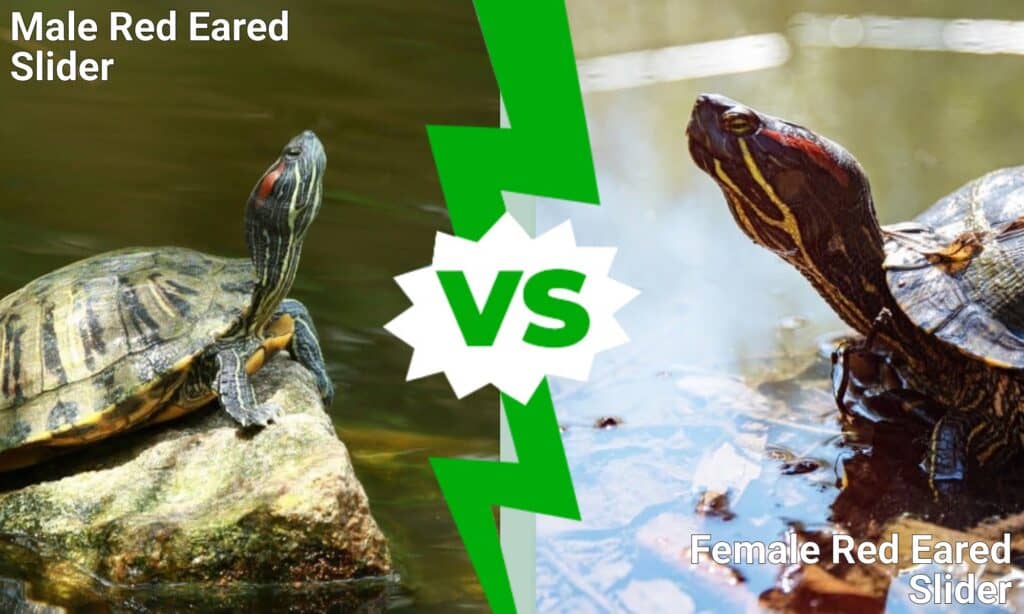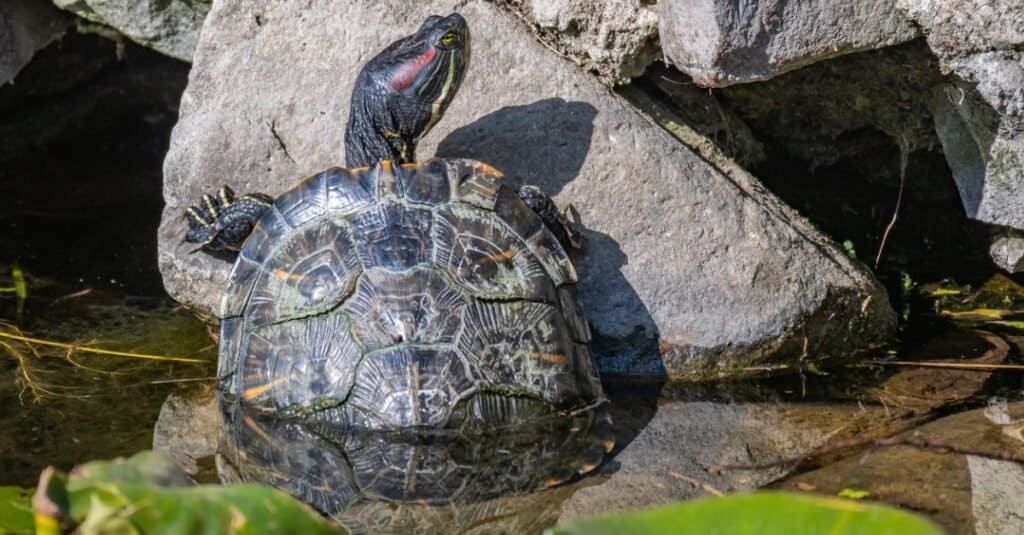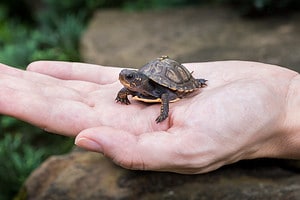
Red-Eared sliders are easily the most popular pet turtle around the world, and that means we know a lot about them! Red-eared sliders are easily identified by their signature red stripe behind the eyes. However, the differences between male vs female sliders are not as well known. The most accurate way to tell them apart is by looking at the tail. Males have thicker and longer tails than females, and a much longer space between the tail and the cloaca.
However, this is not the only way to tell the two apart. Male and female red-eared sliders have other physical differences and behave differently. The gender of your slider does not make much of a difference if you only have one. But if you want to keep multiple sliders in one enclosure, knowing the sex of your turtle is crucial!
Male Vs Female Red-Eared Sliders: Physical and Behavioral Differences

Male and female red-eared sliders look nearly identical, but the best way to tell them apart is by the tail. Males have thicker and longer tails than females.
©iStock.com/:Marina Vedernikova
The easiest way to tell a male from a female is by the length and thickness of the tail and how close it is to the cloaca or vent. But this is not the only physical difference between the two. There are a few more key physical characteristics that help to sex red-eared sliders.
Identifying A Male Red Eared Slider
Male sliders tend to be smaller than females, but this is not a reliable way to tell the gender of a single turtle. In addition to the thicker and longer tail, male sliders also have a longer distance between the tail and the cloaca. Male sliders can also be distinguished by the concave bottom shell. This shell is curved inward in males to make mounting a female easier.
The male red-eared slider also has longer front claws unless they are damaged by inadequate living conditions. Short claws on a male slider are an indicator that the turtle is underdeveloped.
Identifying A Female Red Eared Slider
In addition to being larger than male sliders, females have a much thinner and shorter tail. Female sliders have little to no distance between the tail and cloaca and do not have concave bottom shells. The bottom shell on a female slider is either flat or curves outward,
Male Vs Female Sliders: Differences In Behavior

Male and female-eared sliders do not have obvious behavior differences when kept alone, but males are more territorial than females.
©iStock.com/slowmotiongli
Solitary red-eared sliders do not display noticeably different behavior and most owners do not prefer one gender over the other. However, when kept in the same enclosure or in the wild, male, and female sliders have different behavior patterns. Female sliders tend to pay little attention to another female, as there is no competition for mating. Male sliders will challenge or fight each other during mating season and are very territorial toward other males. Males also perform a mating dance using their long claws.
Can You Keep Red-Eared Sliders Together?

Both males and females can be kept together or with other turtles and animals. However, certain conditions must be met regarding gender and space. Outdoor habitats are best for multiple turtles!
©iStock.com/MriyaWildlife
Both male and female red-eared sliders can be kept with other sliders, as well as with compatible animals like painter turtles. However, there are some extra precautions you should take if you want to put more than one slider or turtle in an enclosure.
The slider is a tough, strong, and large turtle that needs a lot of space. A large slider requires a 50–75 gallon enclosure. Housing multiple sliders requires much more space, and an outdoor pond is ideal for multiple sliders. Smaller sliders tend to be bullied in too-small enclosures and may not be visibly injured but could cease growing!
Red-eared sliders kept together have special requirements regarding gender as well.
Male Red-Eared Sliders Need More Space When Kept Together
Males are territorial when kept in proximity and will need more space. Males should have multiple warming spots, caves, and locations for food. If males are not able to put distance between them, the larger of the two will bully the smaller male. This aggression can result in injury or death if not corrected.
Male And Female Red-Eared Sliders Kept Together
All genders can be kept in the same enclosure with some precautions. Of course, unless you wish to breed them males and females should be separated during mating season. This is because the male will relentlessly harass the female and she can become very aggressive. Even when breeding red-eared sliders, one male should be placed with at least two females. This will minimize stress and give the females time to recuperate.
Does My Red-Eared Slider Recognize Me?
Surprisingly, a lot of people may not be aware of this, but many turtles can actually recognize the appearance and sounds of their owners. In fact, numerous pet owners have shared their experiences of their turtles swimming up to the water’s surface to welcome them when they enter the room.
Red-eared sliders are skilled swimmers, and they adeptly escape potential threats, including humans, by swiftly retreating into the water, which is how they earned their name. When kept in captivity, they can be friendly and even sociable with their human families.
In response to positive reinforcement, they often approach the water’s surface or the side of the tank with curiosity to interact with their caretakers.
Keeping Multiple Species In The Same Habitat
The red-eared slider can share habitats with other species but use caution. Sliders are known to outgrow other species and can outcompete them for food. Therefore, a large outdoor environment is highly recommended for housing multiple species together. Red-eared sliders coexist well with painted turtles and other sliders, as well as other animals. Tankmates should be larger than the slider can consume!
Some catfish species, Plecostomus, Koi, and Goldfish make good tank mates for sliders. Surprisingly, some snail species like mystery snails can also coexist with sliders since they move too slowly to catch the slider’s attention. Some feeder fish that sliders can eat that reproduce faster than the turtle can consume are red minnows and guppies!
The photo featured at the top of this post is © effective stock photos/Shutterstock.com
Thank you for reading! Have some feedback for us? Contact the AZ Animals editorial team.






